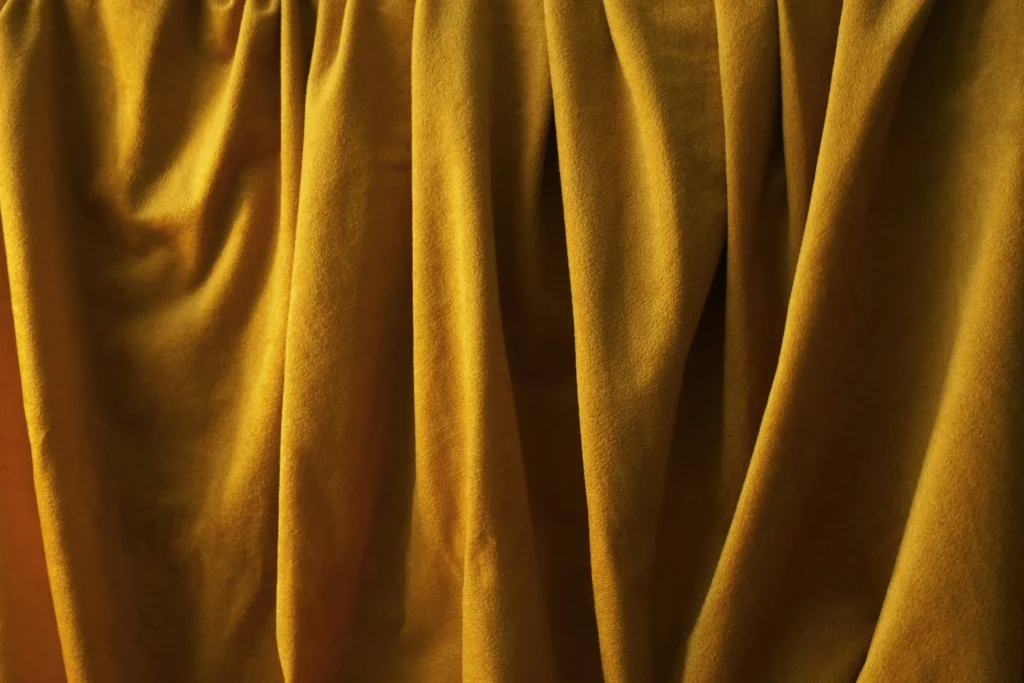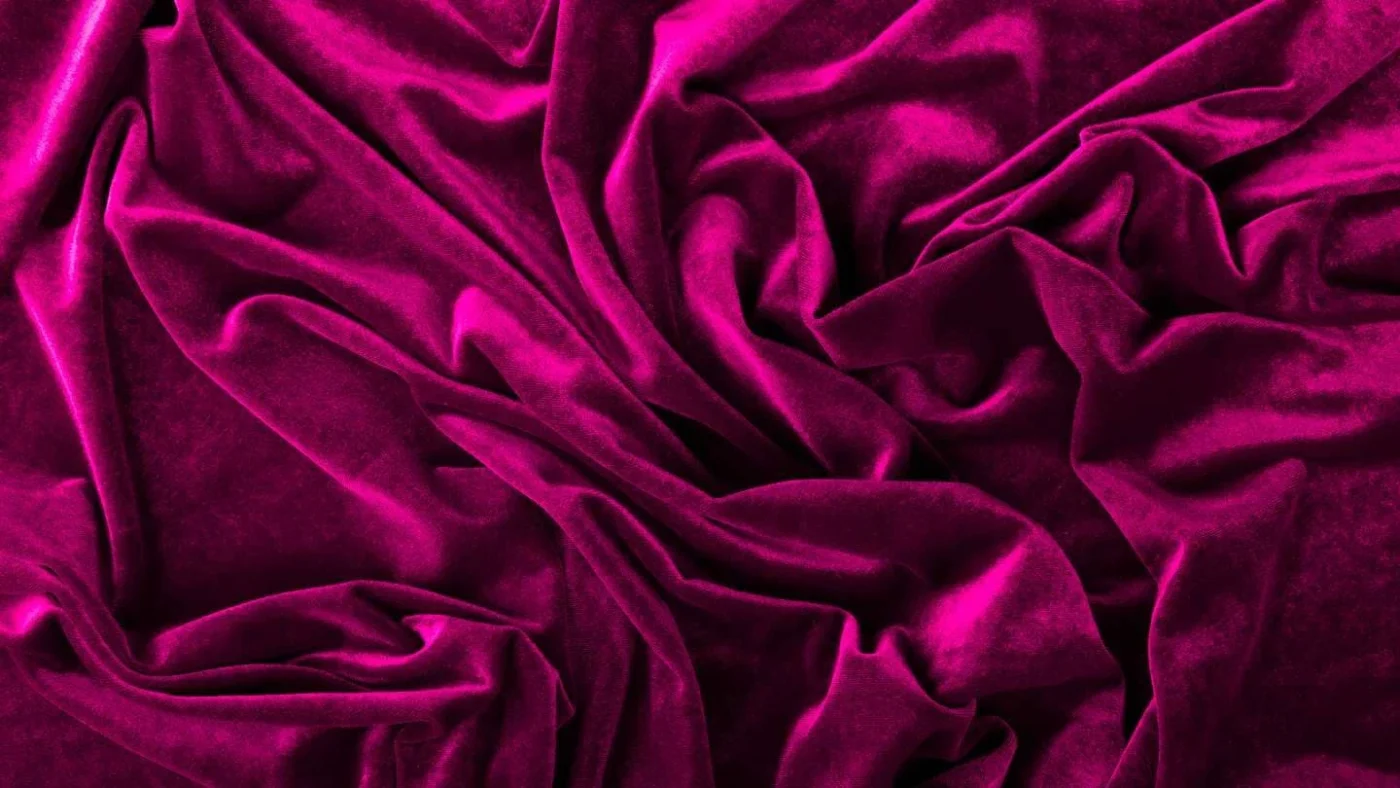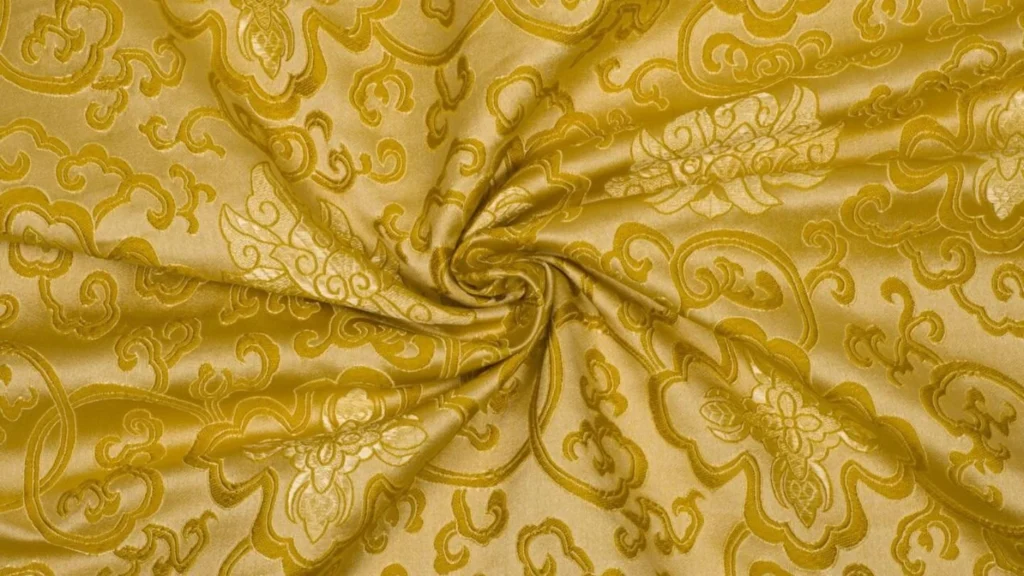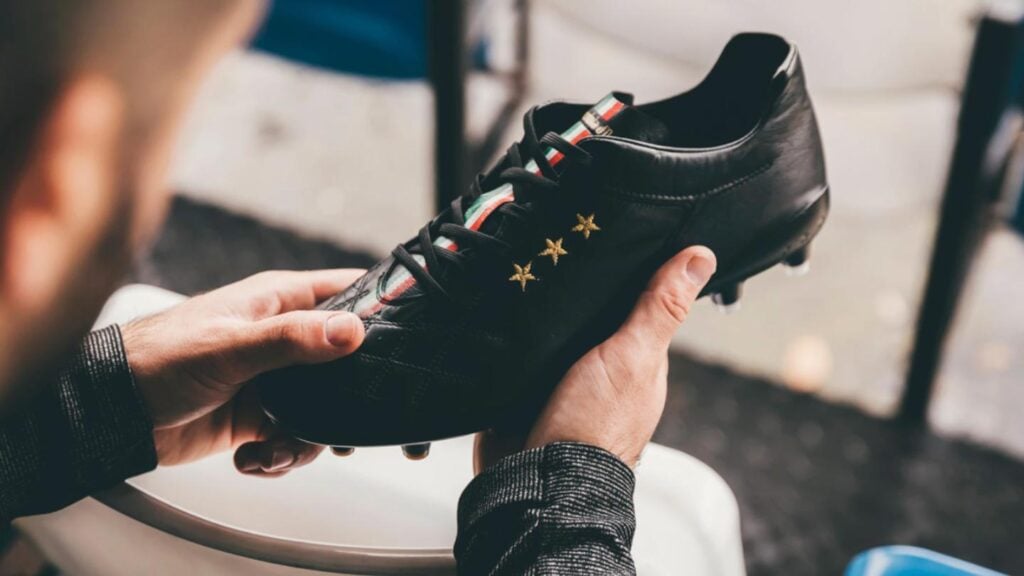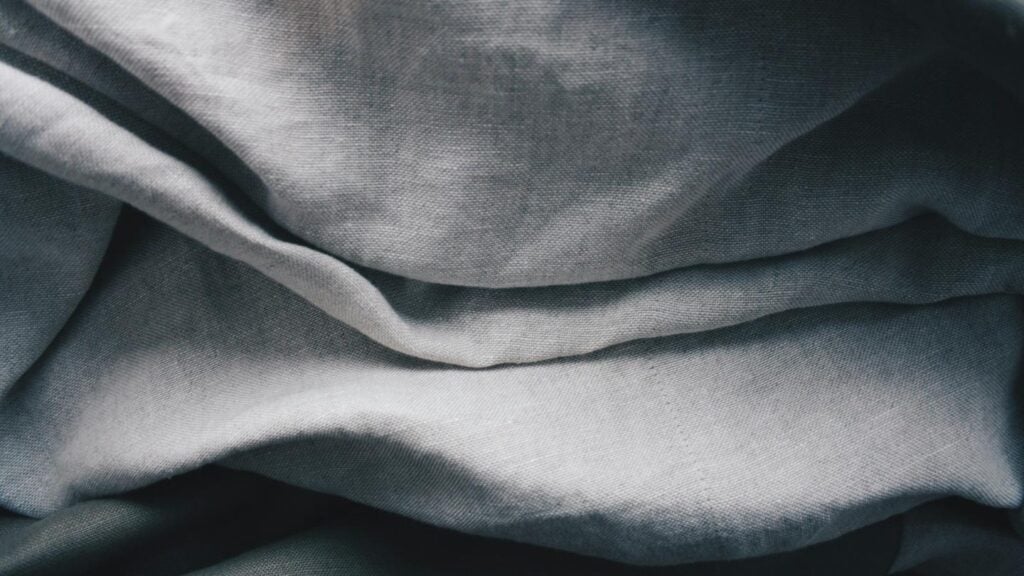2 – Benefits of Choosing Velvet Fabric
3 – Velvet Fabric vs Other Fabrics
4 – How Velvet Fabric Is Manufactured
5 – Common Uses in Fashion
6 – Understanding the Environmental Impact of Velvet Fabric
7 – Exploring Price Points and Value for Money
8 – Conclusion
9 – FAQs
What is Velvet Fabric?
Velvet fabric is a luxurious and distinctive textile known for its soft, dense pile that gives it a rich, plush texture and elegant appearance. Unlike flat woven fabrics, velvet is characterized by a raised surface made of evenly cut fibers that stand upright, creating a smooth, tactile feel that is both visually appealing and comfortable to touch. This fabric has a fascinating origin and composition that contribute to its unique qualities:
- Origin: Velvet dates back to ancient times, with early production traced to regions such as the Middle East and Byzantium. Historically, it was a symbol of wealth and status due to the complex weaving process required to create its signature pile.
- Composition: Traditionally made from silk, modern velvet fabrics can also be woven from cotton, polyester, nylon, or blends, each affecting the texture, durability, and price.
- Structure: Velvet’s pile is created by weaving two layers of fabric simultaneously and then cutting them apart, which results in the characteristic soft surface.
- Properties: Velvet fabric is known for its softness, sheen, and durability. Its dense pile traps light, giving it a shimmering effect that changes with the angle of view and lighting, enhancing its luxurious appeal.
- Varieties: Different types of velvet exist, such as crushed velvet, velour, and panne velvet, each offering variations in texture and stretch.
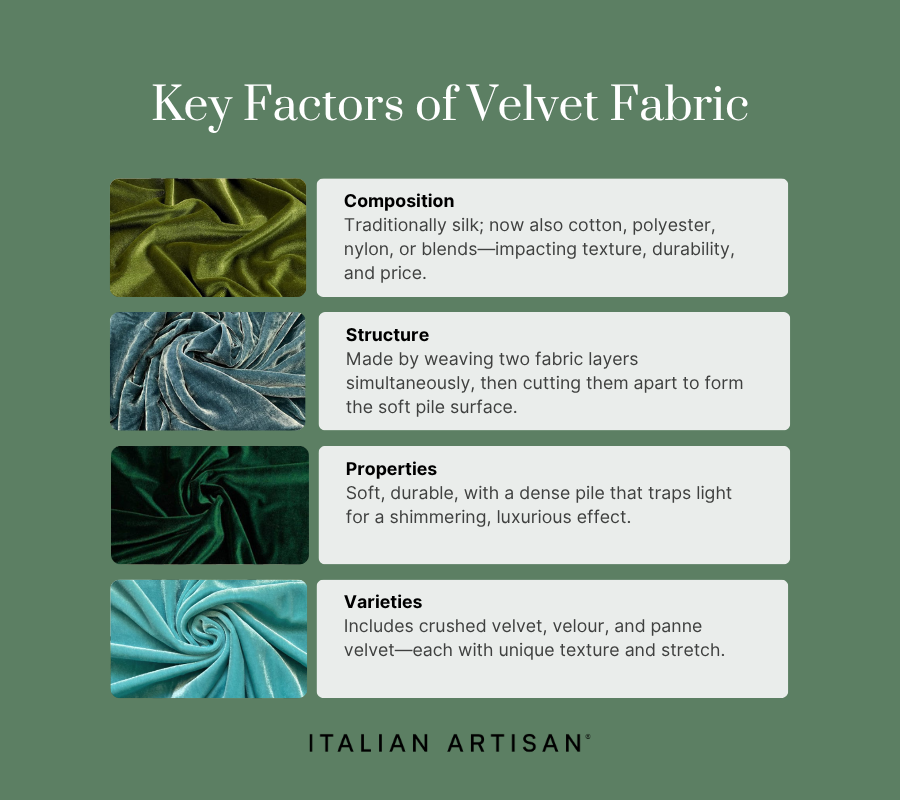
Benefits of Choosing Velvet Fabric
Velvet fabric offers a range of benefits that make it a popular choice in fashion and interior design, combining luxury with practical qualities that appeal to many users. Here are the main advantages of choosing velvet:
- Luxurious Look and Feel: Velvet’s soft, dense pile creates a rich texture and subtle sheen that immediately elevates the visual appeal of any garment or furnishing. This fabric exudes elegance and sophistication, making it ideal for formal wear, evening gowns, and upscale upholstery.
- Comfort and Warmth: Thanks to its plush surface, velvet provides a cozy, warm feel that is comfortable against the skin, especially in cooler seasons. This makes it perfect for winter clothing and soft home textiles like cushions and drapes.
- Versatility in Composition and Style: Available in silk, cotton, synthetic fibers, or blends, velvet can suit different budgets and functional needs without sacrificing its signature softness and appearance. Additionally, varieties such as crushed velvet or stretch velvet add stylistic options.
- Durability and Longevity: When properly cared for, velvet is a durable fabric that maintains its texture and beauty over time. Synthetic velvets, in particular, are resistant to wear and easier to clean than traditional silk velvet.
- Color Depth and Richness: Velvet’s pile structure enhances dye absorption, resulting in deeper, more vibrant colors that stand out compared to flat fabrics. This quality is especially valuable in fashion and decor where bold colors create strong impressions.
Velvet Fabric vs Other Fabrics
Velvet Fabric vs Other Fabrics
When comparing velvet fabric to other common textiles, several unique features stand out, making velvet a preferred choice for certain applications while also presenting some trade-offs. Here’s how velvet compares:
- Texture and Appearance
- Velvet is prized for its soft, plush pile that creates a rich, shimmering surface with a depth and sheen that changes with the light.
Other fabrics like cotton, linen, or wool tend to have flatter surfaces without the same tactile or visual luxury. For example, cotton is breathable and matte, while wool is warm but textured differently.
- Velvet is prized for its soft, plush pile that creates a rich, shimmering surface with a depth and sheen that changes with the light.
- Comfort and Feel
- Velvet feels incredibly soft and smooth against the skin, often associated with comfort and warmth.
Fabrics like silk also feel smooth but are lighter and more delicate; denim or canvas are sturdier but rougher.
- Velvet feels incredibly soft and smooth against the skin, often associated with comfort and warmth.
- Durability
- Velvet can be durable, especially when made from synthetic fibers, but its pile can crush or wear over time with heavy use.
- Fabrics like denim or leather typically withstand wear and tear better, while delicate fabrics like silk require more care.
- Care and Maintenance
- Velvet often needs special care, such as dry cleaning or gentle hand washing, to maintain its texture and avoid damage.
- In contrast, cotton and polyester fabrics are usually machine washable and easier to maintain.
- Use Cases
- Velvet is favored for luxury fashion items, upholstery, and formal wear due to its elegant appearance.
- Other fabrics like jersey or chambray are preferred for casual clothing because of their breathability and ease of movement.
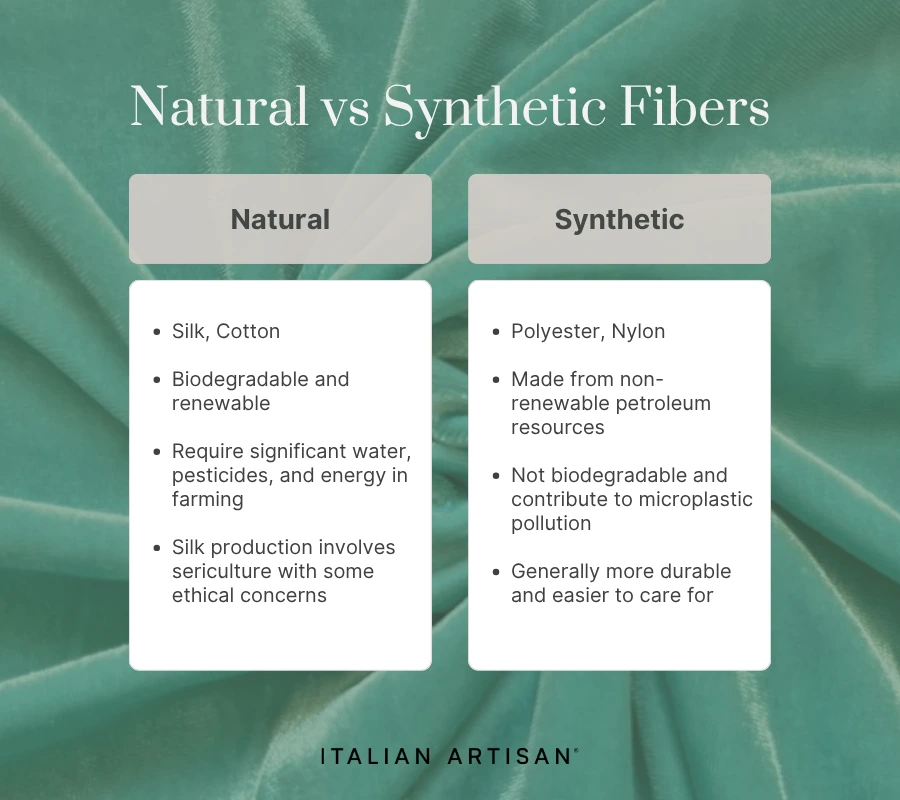
How Velvet Fabric Is Manufactured
The manufacturing of velvet fabric is a unique and intricate process that gives it its signature soft pile and luxurious texture. Unlike regular woven fabrics, velvet is created through a special weaving technique that produces two layers of fabric simultaneously. Here’s a step-by-step overview of how velvet fabric is made:
- Double Weaving Process
Velvet is woven on a special loom that interlaces two separate layers of fabric face-to-face. These layers are connected by an extra set of warp threads, which form the pile or raised surface. - Cutting the Pile
Once the double fabric is woven, a sharp blade cuts between the two layers, separating them into two individual pieces of velvet, each with an upright pile of evenly cut fibers. - Finishing Treatments
After cutting, the velvet fabric undergoes several finishing processes to enhance its softness, sheen, and durability. This can include brushing, steaming, and washing to raise the pile and remove any imperfections. - Fiber Selection and Variation
Velvet can be made from various fibers such as silk, cotton, polyester, or blends. The choice of fiber influences the final texture, weight, and price of the fabric. For example, silk velvet is lightweight and lustrous, while polyester velvet tends to be more durable and affordable. - Types of Velvet
Different weaving patterns and finishing techniques create various types of velvet, such as crushed (which has a deliberately wrinkled texture) or velour (a stretchier, knit version of velvet).
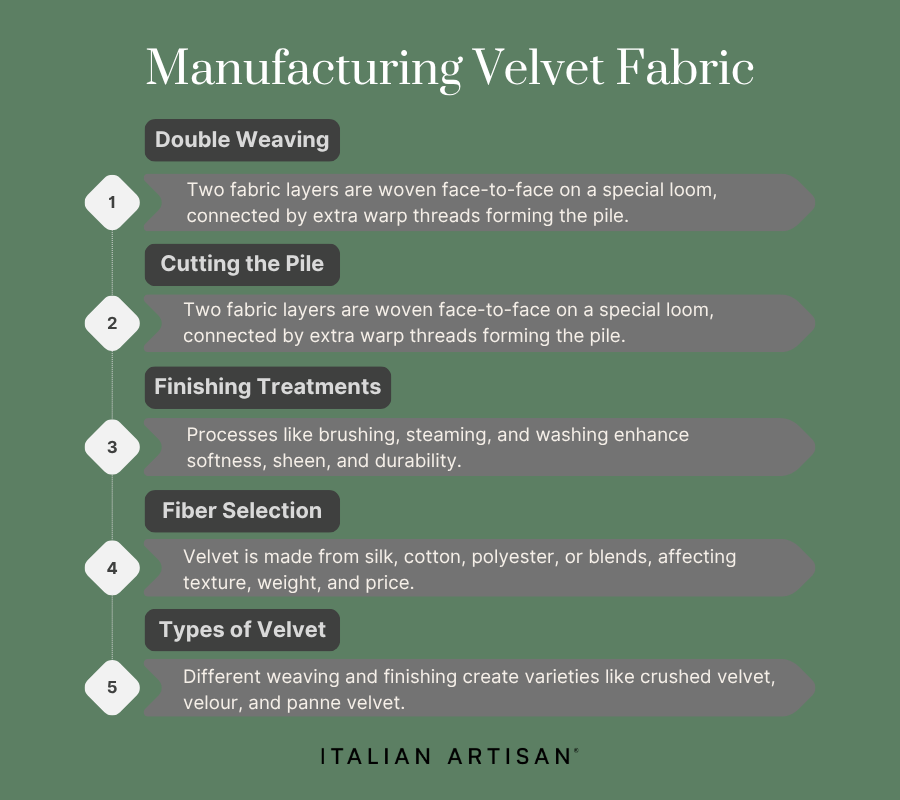
Produce your fashion collection with us
Common Uses in Fashion
Velvet fabric has long been a favorite in the fashion industry due to its luxurious texture, rich colors, and elegant drape. Its versatility allows designers to create a wide range of garments and accessories that combine style and comfort. Some of the most common uses of velvet in fashion include:
- Evening and Formal Wear
Velvet is frequently chosen for gowns, tuxedos, blazers, and cocktail dresses because of its sophisticated appearance and soft sheen, which catch the light beautifully in formal settings. - Outerwear and Jackets
Velvet adds warmth and texture to coats, jackets, and capes, making these pieces both stylish and functional, especially during cooler months. - Tops and Dresses
Velvet’s smooth surface and slight stretch in some varieties make it ideal for blouses, shirts, and casual or dressy dresses, offering both comfort and a touch of luxury. - Footwear and Accessories
From velvet loafers and heels to handbags, hats, and scarves, this fabric is used to add a plush, high-end finish to many fashion accessories. - Menswear
Velvet is popular in menswear for items like waistcoats, suits, and evening slippers, lending a refined and classic look.

Understanding the Environmental Impact of Velvet Fabric
While velvet fabric is celebrated for its luxury and beauty, it’s important to consider its environmental impact, which varies significantly depending on the fiber content and production methods. Here’s an overview to help understand velvet’s sustainability profile:
- Natural vs. Synthetic Fibers
Velvet made from natural fibers like silk or cotton is biodegradable but often requires intensive farming practices that consume water, pesticides, and energy. Silk production, for example, involves sericulture, which has a relatively low environmental footprint but raises ethical concerns regarding silk worms.
Synthetic velvets, typically made from polyester or nylon, are derived from petroleum-based resources. These fibers are less biodegradable and contribute to microplastic pollution when washed. - Energy-Intensive Production
The double weaving and finishing processes used to manufacture velvet consume significant energy and water, especially in traditional factories. However, advances in technology and more sustainable practices are gradually reducing this footprint. - Chemical Usage
Dyeing velvet to achieve its vibrant colors often involves chemical treatments that can be harmful if not managed responsibly. Eco-friendly dyeing methods and certifications can mitigate these impacts. - Longevity and Circularity
One sustainability advantage of velvet is its durability and timeless style, which encourages longer garment use and reduces fast fashion waste. Moreover, recycling and upcycling velvet products can further limit environmental harm.
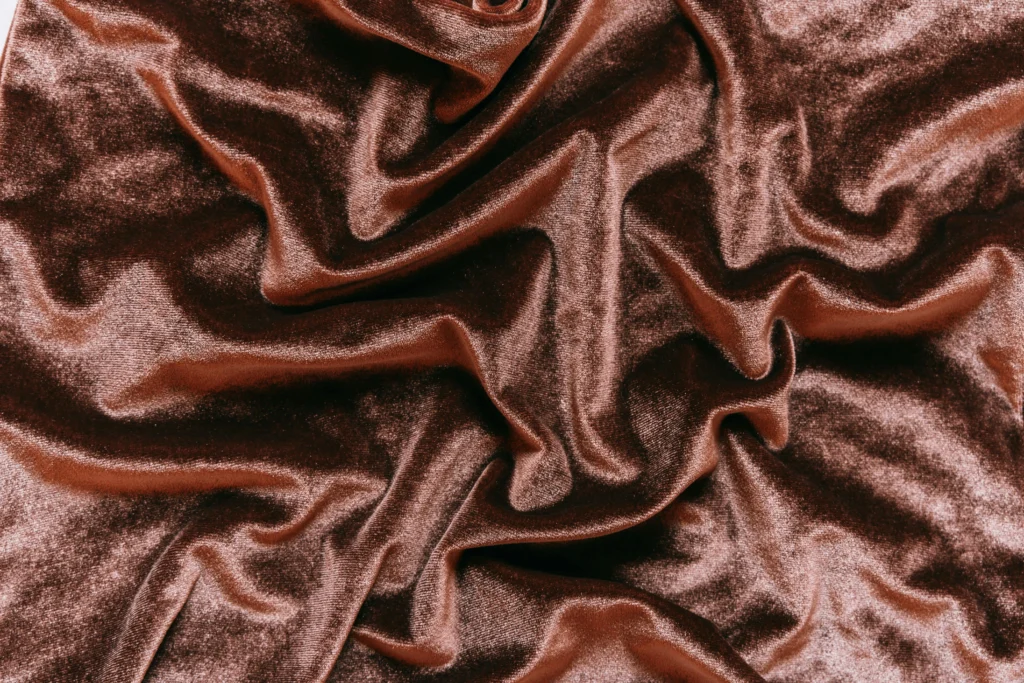
Exploring Price Points and Value for Money
Velvet fabric spans a wide range of price points, reflecting differences in fiber composition, manufacturing quality, and brand positioning. Understanding these factors helps consumers and designers make informed choices balancing cost and value:
- Fiber Type and Quality
Silk velvet, the most traditional and luxurious type, commands the highest prices due to the cost of raw silk and the labor-intensive manufacturing process. Cotton velvet offers a mid-range option, providing softness and durability at a more accessible price. Synthetic velvets, such as polyester or nylon blends, are the most affordable, offering similar aesthetic appeal with easier maintenance but often less breathability and natural feel. - Manufacturing and Finish
Velvet fabrics with high-quality finishing, including hand-brushing, steaming, and special dyeing techniques, tend to be more expensive but deliver superior softness, sheen, and durability. Mass-produced velvets may have lower prices but sometimes sacrifice these premium qualities. - Brand and Market Positioning
Designer labels and luxury brands often use exclusive velvet types and incorporate craftsmanship that justifies higher price tags. Conversely, mass-market retailers offer budget-friendly velvet fabrics suited for everyday fashion and home textiles. - Value for Money
While higher-priced velvets offer unmatched luxury and longevity, mid-range and synthetic velvets provide excellent alternatives that balance affordability with aesthetic appeal. When selecting velvet, it’s essential to consider the intended use, frequency of wear, and care requirements to maximize value.
Conclusion
Velvet fabric remains a timeless symbol of luxury and elegance, cherished for its unique texture, rich colors, and versatile applications in fashion and design. Understanding its origin, composition, manufacturing process, and environmental impact helps consumers appreciate the value behind this plush material. While velvet can vary widely in price and care requirements, selecting the right type based on purpose and budget ensures both beauty and durability. Whether used in high-end garments or sophisticated home décor, velvet continues to captivate with its distinctive softness and visual depth, making it a fabric worth investing in for those seeking style and comfort combined.
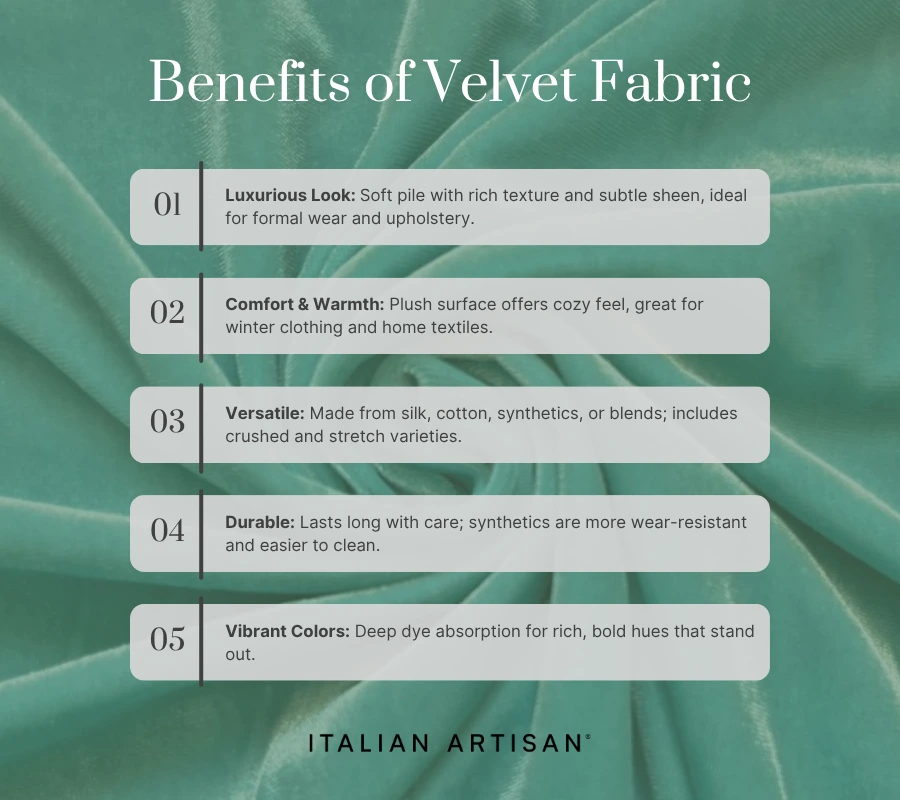
FAQs
- What is velvet fabric made of?
Velvet fabric can be made from natural fibers like silk and cotton or synthetic fibers such as polyester and nylon, each affecting its texture and durability. - What are the key properties of velvet fabric?
Velvet is known for its soft, plush pile, rich sheen, durability, and luxurious feel, making it distinct from other fabrics. - How is velvet fabric different from other fabrics?
Unlike flat-woven fabrics, velvet has a raised pile created by a special double-weaving process, giving it a unique texture and depth. - Is velvet fabric durable?
Yes, especially synthetic velvets, but velvet requires gentle care to maintain its pile and appearance over time. - Can velvet fabric be machine washed?
Most velvet fabrics, particularly silk and some synthetics, require dry cleaning or gentle hand washing to preserve their texture. - What types of velvet fabric are there?
Common types include silk velvet, cotton velvet, crushed velvet, and velour, each offering different textures and uses. - Is velvet fabric environmentally friendly?
The environmental impact varies: natural fiber velvets are biodegradable but resource-intensive, while synthetic velvets have a higher carbon footprint and microplastic concerns. - What makes velvet fabric so expensive?
Factors include the fiber type (silk is costly), the complex weaving process, and finishing techniques that enhance softness and sheen. - Where is velvet fabric commonly used in fashion?
Velvet is popular in evening wear, jackets, dresses, footwear, and accessories due to its luxurious look and feel. - How do I choose the right velvet fabric for my project?
Consider the fiber composition, durability, care requirements, and price, matching them to your specific needs and intended use.
